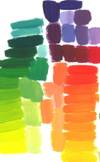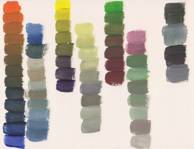Mixing black and darkening colours
If you want to try to make a mixed black you mix all the primary colours together so that they neutralise one another. It can be quite a delicate balance of red with blue and yellow and is sometimes easier to manage when you mix a mid-orange, purple and green because they contain the correct proportions of the primary colours.
The mixed black that you make is a dark neutral or absence of colour. It is different from the black in the tube, but often much more useful when you are painting. The range of greys is also much wider.
 |
Mixed black is a dark neutral colour. Here it has had white added and then touches of its base colours, orange, green and purple, to make some interesting greys. |
When you have mixed a wide range of all the colours your page might look like the one shown at left below. See if you can create more colours than these.
 |
 |
 |
| A page of colour mixtures | Bright secondary colours, mixed from the warm and cool versions of the primary colours, red, yellow and blue | Darker tertiary colours mixed from combinations of red with green, purple with yellow and orange with blue |
When you compare tertiary colours with the secondary colour mixes they seem duller but they are also unusual and interesting colours.
It is also useful to know that, if you mix a colour such as brown and it goes too green, you only need to add a touch of red to neutralise the 'greenness'. All the complementary colours work in this way.
Now you will not have to rely on adding black (which is often far too strong) to darken a colour - you will also be able to darken a colour by adding its opposite colour. When you want to mix realistic colours you will find this a better way of achieving colours that are true to nature.